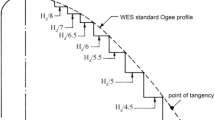Abstract
Nowadays, “Sponge Cities” are being built to provide a valid solution to the glaring drainage problems in the urban areas of China. The hydraulics of a dropshaft, especially discharge capacity, energy dissipation and cavitation damage control, evidently affect its safety and the city’s underground tunnel system, due to the high dropshaft and large discharge. The hydraulic characteristics of stepped spillway dropshafts are experimentally investigated for the variable step rotation angles and end sill heights. Flow regimes inside the dropshafts are classified under the different approach flow discharges. The results illustrate that there is high energy dissipation in the present dropshafts with the stepped spillway and the cavitation damage could be effectively avoided thanks to the effect of the air entrainment to the flow.
Similar content being viewed by others
References
Zhang J Y, Wang Y T, He R M, et al. Discussion on the urban flood and waterlogging and causes analysis in China (in Chinese). Adv Water Sci, 2016, 27: 485–491
Jain S C. Free-surface swirling flows in vertical dropshaft. J Hydraul Eng, 1987, 113: 1277–1289
Jain S C, Kennedy J F. Vortex-flow drop structures for the Milwaukee metropolitan sewerage district inline storage system. IIHR Report. Iowa City: University of Iowa, 1983. No. 264
Granata F, de Marinis G, Gargano R. Air-water flows in circular drop manholes. Urban Water J, 2014, 12: 477–487
Ma Y, Zhu D Z, Rajaratnam N. Air entrainment in a tall plunging flow dropshaft. J Hydraul Eng, 2016, 142: 04016038
Camino G A, Rajaratnam N, Zhu D Z. Choking conditions inside plunging flow dropshafts. Can J Civ Eng, 2014, 41: 624–632
Kennedy J F, Jain S C, Quinones R R. Helicoidal-ramp dropshaft. J Hydraul Eng, 1988, 114: 315–325
Odgaard A J, Lyons T C, Craig A J. Baffle-drop structure design relationships. J Hydraul Eng, 2013, 139: 995–1002
Margevicius A, Schreiber A, Switalski R, et al. A baffling solution to a complex problem involving sewage drop structures. Proc Water Environ Fed, 2010, 2010: 1–9
Wu J, Ren W, Ma F. Standing wave at dropshaft inlets. J Hydrodyn Ser B, 2017, 29: 524–527
Keller R J. Prediction of the behaviour of large vortex drop structures in municipal sewerage systems. In: World Environmental and Water Resources Congress 2007. Tampa, 2007. 1–10
Tamura S, Matsushima O, Yoshikawa S. Helicoidal-ramp type drop shaft to deal with high head drop works in manholes. Proc Water Environ Fed, 2010, 2010: 4991–5002
Carvalho R F, Leandro J. Hydraulic characteristics of a drop square manhole with a downstream control gate. J Irrig Drain Eng, 2012, 138: 569–576
Granata F. Dropshaft cascades in urban drainage systems. Water Sci Tech, 2016, 73: 2052–2059
Camino G A, Zhu D Z, Rajaratnam N. Hydraulics of stacked drop manholes. J Irrigat Drain Eng, 2011, 137: 537–552
Wu J H, Yang T, Shen J Y, et al. Hydraulics of stepped spillway dropshafts with large-angle (in Chinese). Chin J Hydrodyn, 2018, 33: 659–663
Felder S, Chanson H. Energy dissipation, flow resistance and gasliquid interfacial area in skimming flows on moderate-slope stepped spillways. Environ Fluid Mech, 2009, 9: 427–441
Peterka A J. The effect of entrained air on cavitation pitting. In: Proceedings of Minnesota International Hydraulics Convention. Minneapolis. Minnesota, 1953. 507–518
Author information
Authors and Affiliations
Corresponding author
Rights and permissions
About this article
Cite this article
Shen, J., Wu, J. & Ma, F. Hydraulic characteristics of stepped spillway dropshafts. Sci. China Technol. Sci. 62, 868–874 (2019). https://doi.org/10.1007/s11431-018-9366-0
Received:
Accepted:
Published:
Issue Date:
DOI: https://doi.org/10.1007/s11431-018-9366-0



